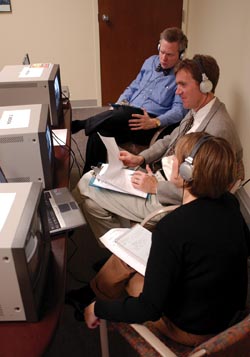
Photo by Dana Johnson
‘My Health’ site’s traffic, capabilities growing fast
The My Health at Vanderbilt patient Web site has mushroomed in use from its test phase and is today registering around 2,100 new users per month from nearly all Vanderbilt Medical Group adult clinics. Pediatric clinics will open the site to children and their parents this summer.
“Patients think it's tremendous,” said endocrinologist Lewis Blevins, M.D.
“They love it when you tell them they can go online to look up their lab results and message their doctor,” said Bonnie Slovis, M.D., medical director of the adult pulmonary and cystic fibrosis clinics.
Each day, 800 to 1,000 patients log on (at www.myhealthatvander-bilt.com) to read lab results and radiology reports from their electronic medical record, ask their physician a question, receive messages from their health care team, schedule clinic appointments, review and pay their hospital and clinic bills, and find articles about chronic illness and disease prevention.
Rather than going directly to providers, My Health messages from patients go to staff members for sorting and forwarding, just as phone calls do.
After review by the provider, all messages between the patient and the team become part of the medical record. Instead of dictation, doctors increasingly use a time saving letter-writing feature embedded in StarPanel, a Vanderbilt medical record application, to write follow-up letters to patients and referring physicians. Now, instead of mailing these letters, doctors can whisk them directly from StarPanel to the patient's My Health in-basket. If the patient doesn't open the message in a defined period of time, it bounces back to the staff for follow-up mailing or a phone call.
“We're seeing faster growth with My Health than with any other site of this kind that we know of,” said Jim Jirjis, M.D., assistant chief medical officer for electronic medical records, My Health chairperson and director of the Adult Primary Care Center.
Positive lab results are highlighted, and all lab results are linked to general explanations written for the consumer.
When a given test has been done more than once, the results are plotted on a graph to allow a quicker grasp of trends.
Jirjis has some ideas about why users are drawn to the site in such numbers — few patient sites offer a comparable range of information and interactivity, he said.
Two-tier registration also appears to help gather users: patients get full access when they register in person at their VMG clinic, but in the meantime they can register online to schedule clinic appointments and ask questions about bills.
Patients will eventually be able to assign different levels of access to their My Health account to anyone whom they want to designate as a delegate.
Because children and some impaired adults can't legally sign a user agreement, programming for delegate access needs to be completed before My Health can be opened to pediatric patients and their parents, as well as to family members of impaired adults.
“The substantial benefits to patient safety are becoming more and more clear as we go,” Jirjis said.
He and Sue Muse, project director for My Health, have begun collecting stories of patients who've been prompted by My Health test results and radiology reports to ask useful questions, in some cases leading doctors to new diagnoses or changes in treatment: Jirjis has seen this happen a couple of times already with his own patients.
As physicians and staff in each clinic are introduced to My Health, Muse and Jirjis have found a pattern of initial reluctance and anxiety giving way to enthusiastic adherence after the site goes into use.
“In order to fit in patient care, research and teaching, academic clinicians tend to compartmentalize their time,” Blevins said.
When the Diabetes Center was preparing to join My Health, “The fear was that, once patients can send messages to their doctor and put notes into their chart, the physician's time will no longer be protected. I was concerned about that myself, but I concluded that the benefits to patients would be worth it. As it turns out, My Health has improved my practice while also helping me compartmentalize my time.”
“It's made my job a lot easier,” said Randy Borland, an administrative assistant in the endocrinology clinic. He formerly had to transcribe messages taken over the phone into e-mail, wait for the physician's or nurse's reply, then try to get the patient back on the phone.
He now simply forwards text. Patient questions also are more succinct: “People are more direct about what they want when they have to type it down,” Borland said.
“They love it,” said Clinic Manager Mary Lou Gudelis, R.N — after four months with My Health, that's the general mood among doctors and staff in the dermatology clinic.
Since clinics must assign staff to receive messages sent to physicians, some physicians have expressed concern that a message could fall through the cracks.
Muse said that's prevented through an ongoing audit of unopened messages: clinics are notified if it appears that any doctor's message basket isn't being properly monitored.
For periodic updates regarding the employee satisfaction survey, see Vanderbilt’s Human Resources Web site, http://hr.vanderbilt.edu/.













